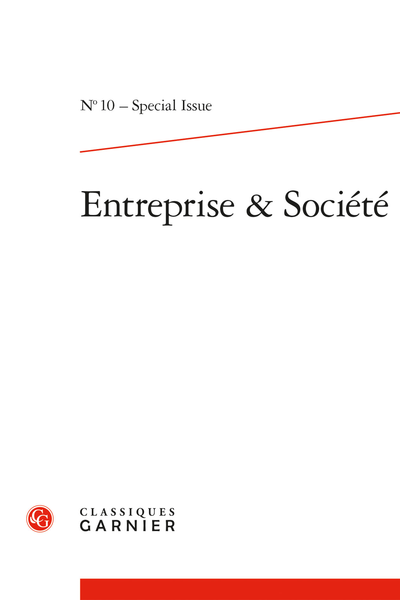
Introduction to the Issue
- Type de publication : Article de revue
- Revue : Entreprise & Société, n° 10 - Special Issue. varia
- Auteur : Jardat (Rémi)
- Pages : 13 à 14
- Revue : Entreprise & Société
- Thème CLIL : 3312 -- SCIENCES ÉCONOMIQUES -- Économie publique, économie du travail et inégalités
- EAN : 9782406142270
- ISBN : 978-2-406-14227-0
- ISSN : 2554-9626
- DOI : 10.48611/isbn.978-2-406-14227-0.p.0013
- Éditeur : Classiques Garnier
- Mise en ligne : 28/12/2022
- Périodicité : Semestrielle
- Langue : Anglais
INTRODUCTION TO THE ISSUE
Rémi Jardat
LITEM –
University of Évry-Paris-Saclay
The purpose of this journal, it should be recalled, is to encourage dialogue between generations of researchers whose work questions the relationship between economics and society. This issue is built around a tribute to an author who died some years ago. Frank H. Knight passed away in 1972, and his major work, Risk, Uncertainty and Profit, was destined to be remembered for good reasons (the distinction between uncertainty and risk), but which also comprised a truncated and distorted legacy. A focus on the first part of his work, which is devoted to decision making in a particular context, is the fate of most mainstream uses of Knight’s thought.
So what exactly is the project that this tribute is acknowledging? Exactly one century ago, Frank H. Knight’s Risk, Uncertainty and Profit was published by the University Press of Chicago. This work, its content and its underyling concept, would place uncertainty at the center of economic analysis. Needless to say, the concept of uncertainty has lost none of its relevance. Major risks – such as pandemics, climate change, and economic crises – all threaten to disrupt the functioning of economies and societies.
The distinction between risk and uncertainty is the tree that hides the forest. The tree is the acknowledgment of the importance of a distinction, albeit a hackneyed one, between risk and uncertainty. But, crucially, the forest represents what we have forgotten about what Knight teaches us, what he outlines – in fact prophesies – in his analyses of economy and society in an uncertain context. Quite unlike the image that history 14has bestowed of him – a history of treatises and battles in which he is chiefly known as one of the founders of the Chicago School – Knight’s perspective is a forward-looking one: the direction that corporations, management, and marketing in particular must take over the course of the century that lay before him. He presages the behavioral theories of decision making and organization that were to develop further, and questions the notion of managerial responsibility. By placing economic thought in a historical context (an approach that has been brought up to date by the current work of Thomas Piketty), he shows how the ideal that prevailed in the 19th century was undermined by the advent of corporations, which induced an uncertainty that would become, whether we like it or not, the only possible current way of thinking. In doing so, far from closing his mind with too pessimistic an observation, he opened the door to a new way of thinking and a new human science.
Romain Laufer and Jérôme Méric are fully supportive of this tribute, which offers an account of Risk, Uncertainty and Profit from a relatively unexplored angle, and which, above all, aims to illuminate the Knightian enigma that has been woven by a posterity founded on partiality and bias, if not downright misinformation. This thematic collection follows this line of enquiry. In “Risk, Uncertainty and Profit,”Emmanuelle Dubocage assesses the premises of venture capital; Jean-Luc Gaffard shows how Knightian uncertainty is one of the reasons, if not the sole reason, why the firm, the managerial figure, and control are necessary; and Stéphane Mottet reminds us that Knight describes a behavioral theory of economics that is very far removed from the scientific schemae that preceded him.